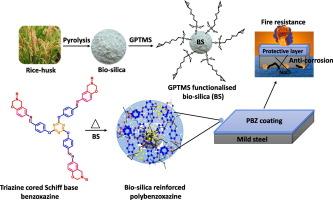三嗪芯席夫碱多功能聚苯并恶嗪/生物硅杂化复合材料增强阻燃性和耐腐蚀性
IF 5.1
3区 工程技术
Q1 CHEMISTRY, APPLIED
引用次数: 0
摘要
在这项研究中,基于三嗪芯苯并恶嗪结构的gptms功能化生物硅增强希夫碱聚苯并恶嗪杂化复合材料被开发用于高性能的耐热、阻燃和耐腐蚀应用。以三嗪基三双酚(CN-IM)和苯胺(a)、糠胺(fa)、月桂胺(la)、硬脂胺(sa)为原料,采用曼尼希缩合法合成了苯并恶嗪单体,并通过FT-IR和NMR对其结构进行了验证。其中,CN-IM-sa由于其相对较低的热稳定性,以及其固有的良好的耐腐蚀性和优越的疏水性,被选择性地用于混杂复合材料的开发,旨在通过生物硅增强来提高其防护性能。在催化剂辅助下,CN-IM-sa的固化温度降至188℃。聚(CN-IM-sa)/生物硅杂化复合材料表现出显著的改善,包括130°的水接触角,99.3%的缓蚀效率,以及高残余炭证实的热稳定性改善。这些结果突出了CN-IM-sa/生物硅杂化材料在腐蚀性环境中作为多功能防腐涂层的潜力。本文章由计算机程序翻译,如有差异,请以英文原文为准。

Triazine cored Schiff base multifunctional polybenzoxazine/bio-silica hybrid composites for enhanced flame and corrosion resistance
In this study, GPTMS-functionalized bio-silica reinforced Schiff base polybenzoxazine hybrid composites, based on a triazine-cored benzoxazine structure, were developed for high-performance thermal, flame retardant, and corrosion-resistant applications. Benzoxazine monomers were synthesized via Mannich condensation using triazine-based trisphenol (CN-IM) and four amines: aniline (a), furfuryl amine (fa), lauryl amine (la), and stearylamine (sa), with structural confirmation by FT-IR and NMR analyses. Among these, CN-IM-sa was selectively used for hybrid composite development due to its comparatively lower thermal stability, along with its inherent good corrosion resistance and superior hydrophobicity, aiming to enhance its protective performance through bio-silica reinforcement. Catalyst-assisted curing of CN-IM-sa reduced the curing temperature to 188 °C. The poly(CN-IM-sa)/bio-silica hybrid composite exhibited significant improvements, including a water contact angle of 130°, corrosion inhibition efficiency of 99.3 %, and improved thermal stability confirmed by high residual char. These results highlight the potential of CN-IM-sa/bio-silica hybrids as multifunctional coatings for corrosion protection in aggressive environments.
求助全文
通过发布文献求助,成功后即可免费获取论文全文。
去求助
来源期刊

Reactive & Functional Polymers
工程技术-高分子科学
CiteScore
8.90
自引率
5.90%
发文量
259
审稿时长
27 days
期刊介绍:
Reactive & Functional Polymers provides a forum to disseminate original ideas, concepts and developments in the science and technology of polymers with functional groups, which impart specific chemical reactivity or physical, chemical, structural, biological, and pharmacological functionality. The scope covers organic polymers, acting for instance as reagents, catalysts, templates, ion-exchangers, selective sorbents, chelating or antimicrobial agents, drug carriers, sensors, membranes, and hydrogels. This also includes reactive cross-linkable prepolymers and high-performance thermosetting polymers, natural or degradable polymers, conducting polymers, and porous polymers.
Original research articles must contain thorough molecular and material characterization data on synthesis of the above polymers in combination with their applications. Applications include but are not limited to catalysis, water or effluent treatment, separations and recovery, electronics and information storage, energy conversion, encapsulation, or adhesion.
 求助内容:
求助内容: 应助结果提醒方式:
应助结果提醒方式:


